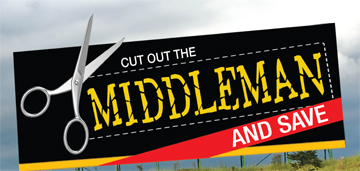Cut out the middleman and save

Distributors must continually demonstrate their value
By Frank Hurtte
Sunshine, perfect temperatures, nothing pressing; it was a fabulous day for one of those old-fashioned Sunday drives. With the steering wheel in my hands and the abundant beauty of America’s rural heartland flying by on both sides of a two-lane U.S. highway, I crested a small hill and there in all its 1960s grandeur stands an old time billboard: “Cut out the middleman and save.” The message was simple; skipping a portion of the supply chain could save you hard-earned cash. Then I realized that distributors are the middleman they were talking about.
Despite our visions of mom’s apple pie, the fair-haired girl next door and all that is good and pure, distribution is not a way of life. Now, before you start gathering your favorite lynch mob and heading out to find me, give me just four minutes to explain what I mean and why it’s important to your world.
Distribution is a business model – albeit a time-honored one – but a business model nonetheless. In my mind, it’s no different from banking, insurance or any other business. For that matter, it’s no different from tinkerer or buggy whip manufacturer. Meaning, this business model exists only as long as it provides value in the current economic environment.
The longest-lasting business models not only provide worth, but have also changed to match the current situation. I believe we, as an industry, deserve high marks for our demonstrated ability to adapt. Let’s explore a couple of examples which come separated by 20 years and a couple of recessions.
The first game changer came in the form of logistics companies. UPS, FedEx and others have changed the value of local inventory, or at least local inventory as we thought of it back in 1978. Distributors can now send shipments that once took days or even weeks to arrive. This created new competition, where alternative distributors and other suppliers expanded to cover larger geographical areas. The small-town distributors had to slowly adjust their value proposition as the perceived value of their stock just down the street was diminished. Some made it; others failed to respond. The results for industrial distributors were the same: closures/mergers and acquisitions.
During the years that followed, distributors rethought their operations. Small standalone locations became branches of larger stores, maintaining inventory to cover emergency or service-truck situations. The wave of consolidations resulted as the very small operations struggled to keep up with the competitive pressures from other distributors, who reacted more solidly to shifts in the environment. Many leaders of today experienced rapid growth during this period. Because customers expected more, and these folks were able to deliver, distributors launched into the first phase of the value-added revolution.
The next big change happened roughly two decades later. Technology shifts began to explode. Computer systems exploded in capacity and complexity. Many touted the Internet as the boogey man destined to eat distribution. And consultants earned zillions with horror stories of “disintermediation.”
I am happy to report that distributors didn’t go away. We adapted to fit a whole new world. Online order entry, rapid communications with supply partners and a whole new round of communications tools put the distributor front and center in a new wave of business trends. Instead of migrating to a world of massive Internet-driven distributors providing brown boxes over the web, existing distributors molded their business to fit the new environment.
Distributors shifted their value statement from local inventory providers to customer problem-solver and furthered their value to suppliers as advanced market builders. Our salespeople shifted from relationship holders to dispensers of customer-focused services. We moved into a brave new world of selling, discussing issues such the elimination of callbacks, breakdowns and energy conservation.
Fast-paced change
Today, we face shifts in the business backdrop with just as sweeping consequences to our industry. And, unlike days of yore when changes took years or perhaps decades to unfold, today compelling changes occur almost instantaneously. Let’s review a couple of these.
Discussion of a pending housing bubble began in 2006, but an equal number of experts panned the idea. Sometime in 2007, it happened almost instantaneously. This caught even some of the brightest minds in our world off guard. By 2008, the pinch was felt throughout the total of American manufacturing. The point is, instead of years to respond, we distributors had just a half-dozen months to react.
The recession, although related to the housing crisis, fell over the American business scene with the same rapidity. Unfortunately, most distributors failed to properly anticipate. In conversations extending as late as summer 2008, most distributors indicated they were weathering “the downturn” well without a great deal of business interruption. Distributors providing solutions into many North American industries actually experienced “reasonably solid” months until the bottom seemingly fell out in October 2008. This time, things changed from “so so” to “oh no” in 45 days.
The truth is our world is shifting at a breakneck pace, and we had better be prepared to react quickly. In addition, it’s also important to point out the world of change isn’t just affecting distributors. On one side, our customers are caught in the same swirling whirlpool, and on the opposite side, our supply partners are spinning as well.
So with this ever-accelerating kaleidoscope of revolution, let’s look into how we had better be prepared to anticipate and position ourselves for the future.
The network news pundits call it the jobless recovery – that’s a misnomer. We’re staring down the jobless reality. The world around us is shifting to doing more with less. The human equation of industry has shifted. Our customers, our suppliers and everyone else are operating with fewer people. For us, it’s a good news and bad news scenario.
The good news? We become an increasingly important source for critical processes within their organization. The bad news? They expect more from us: increased services, logistical support of their business, and greater insight into how we can help them move forward. The point we must consider is that all of this consumes our resources. And in many instances, the current model of gross margin for services does not pan out.
All smaller and quite a few midsize customers lack the buying power to pay for all of the services they will consume. And we continue to face additional downward pricing levels for “technology” driven products. Our business model needs to shift from free service for all to a progressive, fee-based service. Distributors have known this day was coming,
yet continue to procrastinate on setting fees for the things they do for customers.
It’s clear that we add value to our customers, but often we struggle to understand, quantify and measure that value. Distributors who fail to understand this critical point position themselves to constantly be part of the low-price squeeze where they compare your price against the dumbest guy in the market. Without a solid understanding of the value of knowledge provided with your products, your salespeople will face no choice but to provide concessions to shark attacks in the purchasing department.
The relationship we enjoy with supply partners is rapidly morphing, too. We’ve been partners for a really long time, but only a few of us have made the effort to understand how we provide value to them. It’s more than a buy-sell, customer-seller relationship. In fact, contractors and industrials alike are calling upon distributors to provide new layers of value in this backward/reverse direction.
For those of us in distributorland, this translates into proactively developing new customers on behalf of the supplier. But it goes beyond just that, it also means helping that manufacturer be the most efficient producer in the market. Whether we care to admit it or not, we are part of the overall supply chain, and elimination of redundancy in the chain is paramount. In the past decade, we have seen a number of responsibilities formerly handled by manufacturers pushed over to the distributor organizations. With good reason; we can handle the tasks more cost-effectively than our partners.
Now don’t stone me for saying this but, as time moves forward, we will need to up the ante in our part of the total supply chain. We will have to provide inventory reporting, point-of-sale data and other information required to minimize cost from manufacturer
to end-customer. For distributors and their partners, now is the time to work out issues surrounding trust and data security. Since we too will be doing more with few people, we will need to create a methodology for automating the process.
Distributors need to kick their sales process into the next time zone. Today, the vast majority of distributors use a 20-year-old tradition (notice I didn’t say process) of relying on their sellers to develop and maintain a piece of dirt called their “sales territory.” Closer scrutiny demonstrates serious issues with costly duplication of efforts, long ramp-ups of new people and rudimentary forecasting.
This lack of reliable forecasting could easily become our Achilles’ heel. Tight money, tense times in world economies and concerns around interest rates and inflation mandate distributors to improve their skill set to include forecasting, not only for ourselves, but for the other members of our supply chain as well.
Finally, being able to efficiently put these supply-partner teams to work on your growth objectives requires a real sales process defined as documented, measured and enforced. Only when these three areas are put into daily practice can we as an industry expect to demand improvement from our suppliers.
Before we go…
Nearly every one of us can point to examples of organizations surviving in spite of their willingness to swim against the current of business conditions. I still hear stories of the successful electrical distributor who managed to survive well into 1998 without implementing a full-scale ERP business system. And we’ll need to see how that French company does following their total ban of e-mail. But, then again, business models don’t have to change. My guess is there are still openings down at the local buggy whip plant.
And, by the way, God bless the American middleman. If you happen to run across a billboard with a similar message, send us a picture and we’ll give you a preview copy of our new program, Value-Metric Selling.

Frank Hurtte provides Strategic Insight for New Times. He speaks and consults on the new reality facing distribution in a post-recession world. Contact Frank at River Heights Consulting via e-mail at frank@riverheightsconsulting.com or via phone at (563) 514-1104.
This article originally appeared in the Sept./Oct. 2012 issue of Industrial Supply magazine. Copyright 2012, Direct Business Media.













